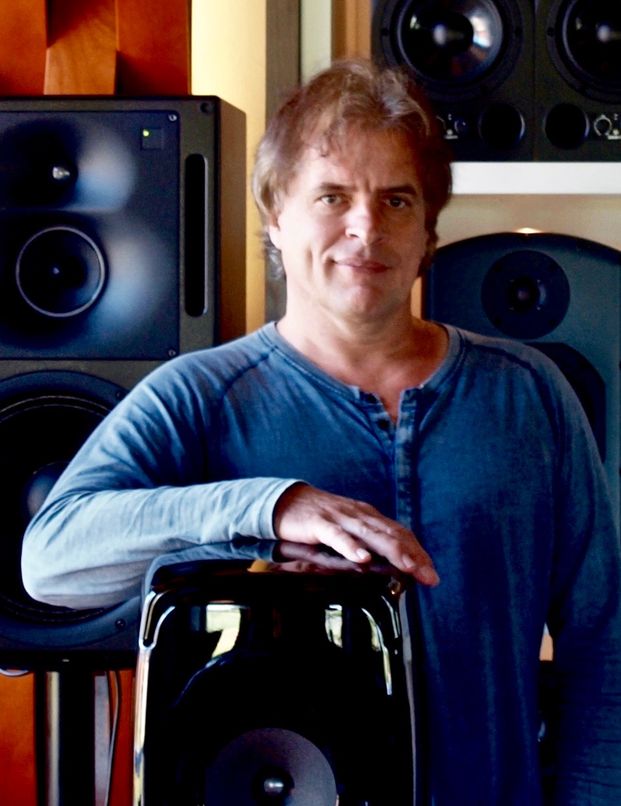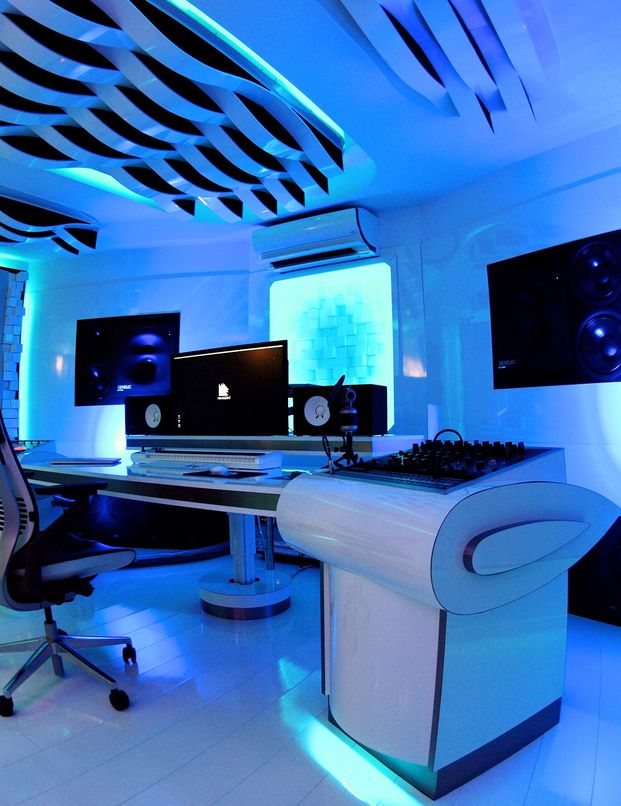“Changing your life or lifestyle is a goal you have to follow with your heart, which is kind of what I'm all about,” Jan Morel tells Headliner. And when you look at the Dutchman's career, you'll understand why. Morel is one of the world's leading recording studio designers, and in the words of Sinatra (almost): he did it his way. Currently working with the biggest names in Electronic Dance Music - David Guetta, Hardwell, Nicky Romero, Martin Garrix, to name a few – it's been an interesting evolution. Morel started out as a classical guitarist, then ended up selling guitars, pianos, drums... and then drum machines, samplers, speakers and consoles, moving seamlessly into the pro-audio sector. Then came the studios, but this is not design in the most conventional manner: Morel's success is down to his relationships, and common sense: a great pair of ears helps, “but that's only after you've seen the problems,” he reminds us, with a smile. We flew out to see Morel ourselves at his beautiful new HQ, an hour out of Amsterdam, to find out more about the man behind the music.
On arrival at Morel's stunning facility: an open plan converted barn, technology oozing out of its pores, I spy an acoustic guitar on the wall, a long table full of guests and snacks, and what seems like a fully licensed bar, complete with waitress. It's difficult not to smile. But this makes sense: he's a gent, he's generous, perhaps a little lavish (his car has 700 horse power), and his world is about building – and keeping – relationships. Seconds later, I'm handed champagne, quickly followed by fine red wine, and I find myself sat in the corner of the property, chatting about the décor with the man himself.
“I started out playing classical guitar – that one on the wall is brand new, but just for show,” Morel smiles, explaining that he grew up in a city with his parents, working in a shop. “I was connected to selling products even in school; and I ended up in a shop selling guitars and other musical instruments – everything, really. That was when I was 17, and I worked there for eight or nine years.”
Morel did consider a life of teaching, spending a year after high school in the salubrious Utrechts Conservatorium, but he soon realised it wasn't for him:
“I discovered I didn't want to be a teacher, because I loved the personal relationships with people: to advise them, and to create something was special to me, even before I did studio design,” Morel reflects. “I started my own shop in 1985 with classical guitars, drum kits, pianos – traditional stuff – and then the switch came when [pro-audio and MI company] Roland entered my shop and asked me to sell their synthesizers and drum computers. I thought, 'who needs a drum computer, we have drummers, idiot!' [laughs] But I started to sell them, at €1,000 a go, and it was very easy, I can tell you!
“Every day, we would sell a drum computer, not a drum kit, so I fell in love with them! Next to them was synthesizers, which I couldn't demo, because I can't play one. However, I could tell people how to use them. If you have a nice resonant sweep, and the customer can press the key and feel he is making that beautiful sound, that's much better than the organ sellers who play all their favourite songs to you! So I would look into their eyes and say, 'what do you think of this sound?' It's so much more of a personal touch.”
LAYING THE FOUNDATIONS
This was a great foundation, Morel insists, for the work that came a few years later with some of the great DJs and producers he now cites as not just colleagues, but close friends.
“You need to know the person, and what they're all about; after all these years, you can still make the same mistake picking the wrong face, as they will give you shit and start complaining,” Morel laughs, a little tongue-in-cheek. “But for me, it's always a challenge to be there, and to fix it, so it's very important to work for a person you like, as you have to share a lot. That's just personalities.”
After the Roland introduction – and Morel's bizarre love affair with drum computers – the first set of very successful producers started walking into his life, but at the time they only focused on equipment, not studio design. This was during the early '90s.
“We were selling some serious kit at this point: Soundtracs consoles, tape recorders, high-end samplers, all that kind of stuff. We had Vengaboys, and we did a lot for 2 Unlimited, as well. Recording was where it was at,” Morel recalls, fondly. “It was a really nice time, because everyone was spending money on nice equipment, and all the kit was sensational. It's funny how things change: back in the day, we'd order 10 Roland D50 synths and it wouldn't be enough, but now you order one, and it's more than enough!”
Morel is no doubt referring to hardware versus today's affordable MIDI synths, virtual instruments, plugins, and so on. So when did the transition to studio design occur, then?
“It started with DJs; they came to me and said they needed a better sound, and we were selling very expensive equipment, but just putting carpet on walls at that time for acoustic treatment. It was very much, 'oh, that will do',” Morel smiles. “I looked around, saw brands selling foam, wooden panels, and so on, then we started with [hard techno DJ duo] Showtek – that was our first project, seven years ago; and from there, it's been a bit of a domino effect, and there is big budget for it.”
HEADROOM
Morel isn't your textbook acoustician: his designs and audio analysis “comes from somewhere in my head,” he explains, with a chuckle. “I really didn't learn about acoustics, I just did what I thought was right, and kept it simple... And it works!”
Evidently so! Morel is close knit with many of the world's top DJs, most of whom want deluxe recording spaces, which Morel not only designs and builds for them, he sets up the audio feeds, too.
“It's basically happenend through word of mouth,” Morel admits. “I remember Hardwell gave me a call, and I was sitting on a terrace with my friend. I said to him, 'OK, I'll call you back, I'm drinking wine right now,' and then my kid said, 'Hardwell? Dad that's the number six DJ in the world!' I was like, 'Oh, I'd better make him number one in the world, then!' [laughs] So I called him back... This was three or four years ago. And the rest is history.”
We should point out that Hardwell – who donned Headliner's cover in Issue 13 – did make it to the top spot, and now sits at number two, sporting a massive 8.5m Facebook likes, and 2.9m Twitter followers. Morel has designed several outstanding studios for Hardwell, and is in the process of making perhaps his most audacious yet:
“We are putting the Wooden Wing (a console designed by Morel, to avoid hard surface reflections that occur in producer rooms around the desk) into a new studio in Ibiza for Hardwell; he will be there from July to October this year,” Morel explains. “I have been out to see the studio part of it, so I will do my design. I will bring in natural wood colours for the Spanish Ibiza style, then basement diffusers with black bamboo. It'll be fucking amazing.”
SUPERSONIC
We both pause for a second, then laugh in unison. It's a ludicrous job this man's got, we decide.
Conversation quickly turns back to technology: if there's one thing Morel does know inside out, it's audio equipment; and the starting point – once the acoustics are sorted - in making any studio facility worth its weight in Gold (or bamboo) is the perfect set of studio monitors.
“I have a very close contact with the Genelec distributor [in Holland], and I was selling a lot of the 8000 Series Genelecs, and then I got Hardwell on the 1000 Series Genelecs, and it was the start of an explosion,” Morel enthuses. “Genelec hadn't sold the huge [Genelec 7073] subwoofer before in Holland, so that was a big thing. And those big Genelecs, I had no previous experience with at the time. So I was talking to Hardwell, and he had a deal with another leading loudspeaker brand, and could have had a set for free, but I showed him the Genelecs, and there was no question in either of our minds; we started it rolling right there.
“It's not only low fatigue you get with Genelecs; any Genelec monitors can go soft, but provide you with full dynamics. At a low level, they will give you the whole sonic image, which does not happen with many speakers. But for this kind of [EDM] setup, you need the power, so that's what we went for.”
When it comes to speccing a room, it starts with the eyes, then the voice, Morel says. What about the ears..?
“[laughs] Well, you see things first, so that's the fastest way to work out if something might cause a problem, so you start with your eyes,” Morel explains, widening his glare at me. We both laugh (again). “So you can physically see the problems already, and then you start talking; and when you have a low voice like I do, you can demonstrate where the issues are without doing any measurements: our eyes and ears are much faster than any measurement too, you see. So if you walk around, you do those tests, then you can do a measurement, as customers want to see a calibration microphone, but doing this in an empty room isn't so helpful, because the program doesn't tell you what to do about it: 'OK, it's shit, and if we do nothing, it'll still be shit! So there is no solution, as such.
“So from there - and it all depends on the style of the property – you see what you can do that fits the customer's needs and the building, and then put everything together. The next step is to make simple drawings, and to make sure the contractors you use understand what you're doing. You start with the ceiling and the inner shell, as it often needs reshaping, and then you go from there.”
Morel makes it sound pretty simple, but clearly this is a fine art. It is also evident that he's got to where he has through sheer love and determination: eyes, voice, ears, and a lot of heart, right Jan?
“[smiles] I just do it, I guess, so yes, that is right,” he says, softly.
On that note, we head to the bar – his bar – and as his musical guests continue to drink wine and be merry, while occasionally changing his Spotify playlist, which is blaring out of one of his pairs of Genelecs, you can only admire what this man has achieved. Be thankful, any fan of EDM music, because without Mr. Morel, the sound of those records wouldn't be quite the same.

